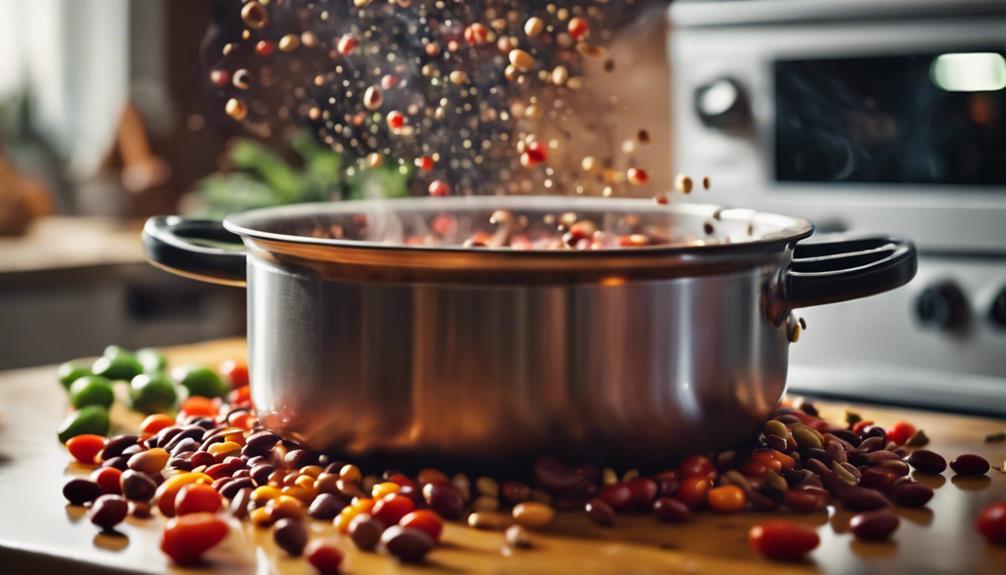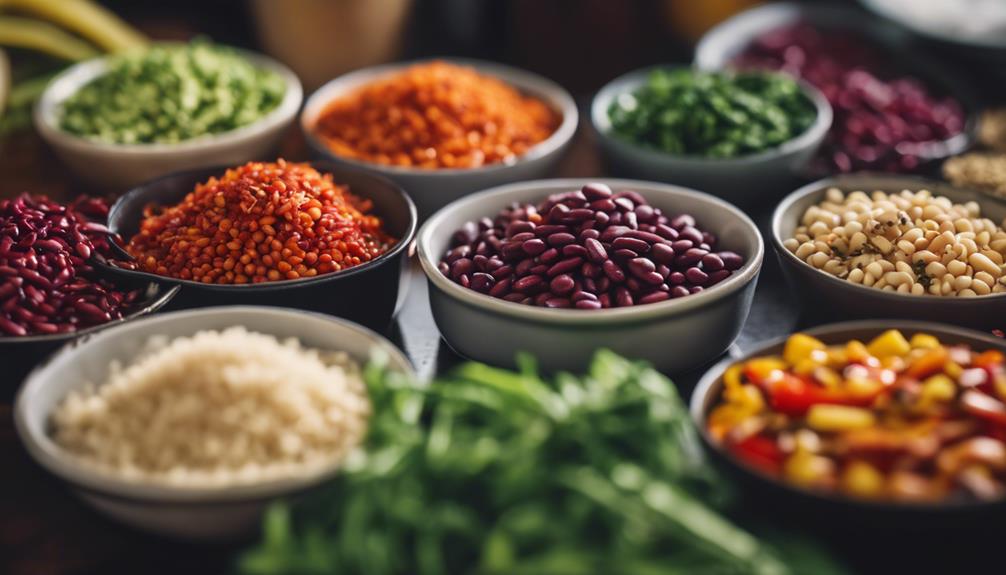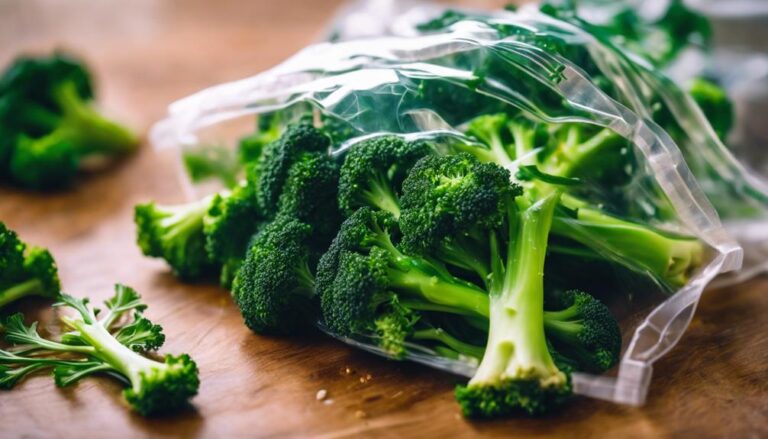Sous Vide Spicy Bean Chili
Get ready for a flavor explosion with sous vide spicy bean chili. Tender meats, infused flavors, and a hint of heat await in this delightful twist on a classic dish. Elevate your culinary experience by mastering the control of cooking temperature, ensuring tender meats and well-infused tastes. Experiment with various meats like beef or pork to create exciting chili variations. With a touch of creativity, you can combine smoked and sous-vide meats for a complex texture and taste. Perfect temperatures and cooking times are key for achieving distinct flavors and harmonious blending. Uncover the secrets to a truly exceptional chili.
What You Will Learn Here
- Sous vide method enhances flavors and textures of spicy bean chili.
- Precise temperature control ensures tender beans and well-infused spices.
- Experiment with different types of beans for diverse and satisfying chili.
- Infuse smoky flavors by using smoked ingredients in sous vide preparation.
- Customize spice levels to create a perfectly spicy bean chili to suit preferences.
Chili's Origin Story

Chili's history traces back to Texas, where it was born out of a fusion of Mexican and American culinary influences.
The evolution of chili showcases how regional preferences and available ingredients have shaped its diverse variations.
Understanding the cultural significance of chili illuminates its role as a beloved comfort food with deep roots in American cuisine.
Chilis Historical Roots
How did the rich and vibrant flavors of chili come to be intertwined with the culinary history of the American Southwest?
Chili's journey traces back to the American Southwest, with its roots firmly planted in Texas. Originally, this hearty dish featured a blend of ground beef and dried chilies, reflecting the influence of Mexican cuisine. Early versions of chili were crafted by slow-cooking meat, chilies, and spices to create a robust flavor profile.
These traditional recipes have stood the test of time, evolving over the years to include ingredients like beans and tomatoes. The historical significance of chili is undeniable, with the first recorded chili con carne recipe dating back to the early 1800s, marking its enduring popularity and cultural relevance in the United States.
Evolution of Chili
The evolution of chili from its humble origins as a simple beef and chiles stew to a complex dish incorporating a myriad of ingredients showcases the dynamic and inventive nature of American culinary history.
Originally, chili consisted of ground beef, chiles, and a few basic seasonings, but over time, it transformed into a rich and flavorful concoction with the addition of tomatoes, onions, garlic, and various spices.
The evolution wasn't limited to just ingredients; it also encompassed cooking techniques and regional variations, leading to the creation of distinct styles such as Texas Red Chili and Cincinnati Chili.
This evolution reflects the diverse culinary influences and creativity in American cooking, demonstrating how a humble dish can become a symbol of cultural heritage and culinary innovation.
Cultural Significance of Chili
With its roots firmly planted in Texan culinary history, the savory concoction known as chili has evolved into a beloved dish celebrated for its hearty flavors and cultural significance. Originating in Texas in the 19th century, chili con carne, a dish made with beef and chiles, gained popularity among cowboys and quickly became a staple in Texan cuisine.
The first recorded recipe for chili con carne dates back to the 1850s, showcasing its deep historical roots. Traditionally cooked outdoors in iron pots over open fires, chili became synonymous with communal gatherings and shared meals.
The Texas Chili Cook-Off, which began in the 1950s, further fueled the chili craze, inspiring various adaptations and interpretations of this iconic dish.
Key Chili Components

One of the essential elements in crafting a flavorful and robust chili is the combination of beef, chiles, onion, garlic, and an array of spices. When preparing your chili, make sure you have the perfect balance of these key components to achieve a delicious and satisfying dish. Here are some critical components to ponder:
- Ground Turkey: Utilizing ground turkey instead of beef can offer a leaner option without compromising on taste.
- Chili Powder: The cornerstone spice in any chili recipe, chili powder provides that signature warmth and depth of flavor.
- Onion: Sauteed onions add a sweet and savory note, enhancing the overall complexity of the dish.
- Garlic: Aromatic and pungent, garlic brings a rich earthiness that complements the heat of the chiles.
- Spices: Cumin, paprika, and oregano are just a few examples of spices that can elevate your chili to new heights, adding layers of complexity to each spoonful.
Chili Variations to Explore
Explore exciting variations in your chili recipes by incorporating smoked brisket or chuck for a robust flavor profile. Consider adding pulled pork to infuse richness into your chili, or experiment with different meats to elevate your dish.
Enhance the freshness of your chili with cilantro and deepen its flavor with tomato sauce and paste.
Sous Vide Spicy Bean Chili
Enhance the bold flavors of your bean chili by exploring exciting variations through the sous vide cooking method. When preparing your spicy bean chili sous vide style, consider these variations to elevate your dish:
- Smoky Chipotle: Infuse a smoky kick by adding chipotle peppers to the sous vide bag.
- Mexican Mole: Enhance the complexity with a rich mole sauce during the sous vide process.
- Tangy Citrus: Add a burst of freshness by including citrus zest and juice in the chili mix.
- Herbaceous Blend: Elevate the aroma with a bouquet garni of fresh herbs like thyme and oregano.
- Umami Boost: Intensify the savory notes by incorporating a dash of soy sauce or miso paste.
These variations will take your spicy bean chili to new heights of flavor complexity and depth.
Sous Vide Bean Medley
Savor the dynamic flavors and textures of a sous vide bean medley, a unique take on traditional chili where beans shine as the primary protein element. When preparing this chili recipe, consider the following:
- Variety: Mix different types of beans like black beans, kidney beans, and chickpeas for a diverse texture.
- Seasoning: Experiment with a blend of chili powder, cumin, and smoked paprika to enhance the flavors.
- Cooking Time: Sous vide cooking guarantees precise tenderness and flavor infusion without overcooking the beans.
- Customization: Tailor the spices and seasonings to suit your taste preferences for a personalized bean chili experience.
- Nutritional Value: Sous vide retains the beans' nutrients, making this dish a healthy and satisfying choice.
Sous Vide Cornbread Topping
For a delectable twist to your traditional chili, consider incorporating a sous vide cornbread topping that adds a unique and flavorful dimension to your dish. Cooking the cornbread sous vide guarantees a moist and tender texture, while the precise temperature control of the sous vide method ensures consistent results every time.
Here are some tips for creating a delicious sous vide cornbread topping:
- Brown Butter: Infuse your cornbread with the nutty flavor of brown butter.
- Honey Drizzle: Add a touch of sweetness by drizzling honey over the cornbread.
- Chili Flakes: For a spicy kick, sprinkle chili flakes on top of the cornbread.
- Cheddar Cheese: Incorporate shredded cheddar cheese into the cornbread batter for a gooey and savory twist.
- Jalapeños: For an extra burst of heat, chop up some jalapeños and mix them into the cornbread batter before cooking.
Pair this flavorful cornbread topping with your spicy bean chili for a mouthwatering meal experience.
Chili Bean Garnish Ideas
When it comes to topping your chili beans, the possibilities are endless.
From creamy shredded cheddar cheese to fresh cilantro for a burst of color and flavor, the choices are varied.
Don't forget sliced avocado for a creamy texture, a dollop of tangy sour cream, and crunchy crumbled tortilla chips to elevate your chili bean dish.
Topping Options for Chili
Enhancing your Sous Vide Spicy Bean Chili with a variety of topping options can elevate the flavors and textures of this hearty dish. After making chili, consider topping it with diced onion for a crunchy bite and a hint of sharpness.
Sprinkle shredded cheddar cheese to add a creamy and rich flavor that melts into the hot chili, enhancing its overall taste. For a invigorating twist, chop fresh cilantro and sprinkle it on top to give a burst of herbaceousness.
Sliced jalapeños offer a fiery kick and a pop of color, intensifying the flavor profile. A dollop of sour cream can balance out the heat with its cool creaminess.
Eventually, crumbled tortilla chips or strips provide a satisfying crunch and a savory corn taste that complements the chili perfectly.
Garnish Ideas for Chili
To truly elevate your Sous Vide Spicy Bean Chili to the next level, consider the perfect garnish ideas that will tantalize your taste buds and add a burst of complementary flavors and textures.
Sprinkle a touch of cayenne pepper on top of your chili for an extra kick of heat that will awaken your palate.
A dollop of sour cream or Greek yogurt will provide a cooling effect, balancing out the spiciness of the dish.
Don't forget to swirl in a spoonful of tomato paste for a rich and savory depth of flavor that will enhance the overall taste profile of your chili.
These garnish ideas, along with the traditional favorites like shredded cheddar cheese and fresh cilantro leaves, will transform your chili into a culinary masterpiece.
Bean Chili Toppings
For a vibrant explosion of flavors atop your bean chili, consider a medley of sour cream, shredded cheese, diced onions, and fresh cilantro as classic garnish options.
To elevate your chili further, try adding avocado slices, jalapeños, tortilla strips, and lime wedges for a burst of freshness and heat.
Experiment with a dollop of Greek yogurt or a sprinkle of green onions to enhance the overall taste profile.
For a creative twist, chopped tomatoes, pickled jalapeños, sliced radishes, and a drizzle of hot sauce can provide a unique and zesty kick to your dish.
When preparing these toppings in advance, use a vacuum sealer and the displacement method to maintain freshness and flavor until serving time.
Customize your bean chili with different combinations of toppings to suit your individual preferences and create a delightful culinary experience.
Final Thoughts
In conclusion, the sous-vide technique has undeniably elevated the chili cooking experience for many members, showcasing its versatility and flavor-enhancing capabilities. Making chili using sous-vide allows for a vital control of the cooking temperature, resulting in tender meats and well-infused flavors.
Experimenting with different types of meats, such as beef or pork, can bring exciting variations to your chili dishes. Members have found that combining smoked and sous-vide meats adds layers of complexity to the texture and taste profile of the chili, creating a truly unique dining experience.
When using sous-vide for chili, it's essential to pay attention to the temperatures and cooking times to guarantee the meat retains its distinct flavors while blending harmoniously with the chili base. Overall, the feedback on sous-vide chili has been overwhelmingly positive, with many considering it a valuable technique that enhances the overall quality of the dish.
Frequently Asked Questions
Can You Sous Vide Chili?
Yes, you can sous vide chili. Sous vide techniques offer precise temperature control for even cooking. This method infuses flavors, tenderizes meat, and eliminates the need for constant stirring. The result is a flavorful and tender chili.
Can You Overcook Bean Chili?
You can definitely overcook bean chili if not careful. It risks ruining bean texture and flavor development. Maintain vigilance; avoid mushy beans or disintegration. Keep an eye on cooking time for perfect bean integrity and a tasty dish.
Is There Anything You Can Add to Chili to Make It Less Spicy?
To balance the flavor and reduce the heat level of chili, you can add cooling ingredients like dairy products, sweetening agents, starchy components, acidic elements, or increase volume with more broth or veggies. These additions help mellow out the spice.
Can You Sous Vide Dry Beans?
You can sous vide dry beans by pre-soaking for ideal texture. This technique enhances bean flavor and preserves nutrients effectively. Cooking at 185°F for 6-8 hours guarantees they are fully cooked and tender.
Conclusion
To sum up, this sous vide spicy bean chili is a delicious and versatile dish that can be enjoyed on its own or paired with your favorite toppings.
The slow cooking method of sous vide guarantees that the flavors are perfectly melded together, creating a rich and hearty chili that's sure to please.
With endless variations and garnish options to explore, this chili recipe is a must-try for any chili lover looking to spice up their mealtime routine.











